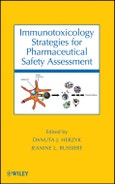- An important reference which provides an overview of the current and recently introduced methodologies for testing the immunotoxic risks in drug candidates
- Helps readers understand the significance of the methods and approaches to immunotoxicology testing
- Aids drug scientists in industry and regulatory areas to consolidate approaches to immunotox testing
- Offers a definitive assessment of nonclinical models to study the toxic impacts (bio)pharmaceuticals can have on the immune system
- Includes chapter authors from across the pharma industry, bringing a real-world and applied perspective to immunotox testing
Table of Contents
Preface.Contributors.
Introduction to Immunotoxicology (Jack H. Dean).
Part I: Current regulatory Expectations for Immunotoxicity Evaluation of Pharmaceuticals.
1. Current Regulatory Expectations for Immunotoxicology Evaluation of Pharmaceuticals (Kenneth L. Hastings).
Part II: Weight of Evidence Review: A New Strategy In Immunotoxicology.
2.1. Clinical Pathology as Crucial Insight into Immunotoxicity Testing ( Ellen Evans).
2.2. Histomorphology of the Immune System: A Basic Step in Assessing Immunotoxicity (Patrick Haley).
2.3. Need for Spectacled Immunotoxicity tests (Kazuichi Nakamura).
2.4. Specific Drug-Induced Immunotoxicity: Immune-Mediated Hemolytic Anemia (Raj Krishnaraj).
Part III: Nonclinical Core Immunotoxicity Testing in Drug Development.
3.1.1. T Cell-Dependent Antibody Response tests (Joseph R. Piccotti).
3.1.2. Natural Killer Cell Assay and Other Innate Immunity Tests (Lisa Plitnick).
3.1.3. Cellular Immune Response In Delayed-Type Hypersensitivity Test (Karen Price).
3.2. Evaluation of Drug Effects on Immune Cell Phenotypes (Laurie Iciek).
Part IV: Extended Immunotoxicology Assessment: EX VIVO Models.
4.1. Functional Cellular Responses and Cytokine Profiles (Elizabeth R. Gore).
4.2. Application of Flow Cytometry in Drug Development (Padma Narayanan, Renold J. Capocasale, Nianyu Li, and Peter J. Bugelski).
Part V: Extended Immunotoxicology Assessment: IN VIVO Models.
5.1. Animal Models of Host Resistance (Gary R. Burleson and Florence G. Burleson).
5.2. Approaches to Evaluation of Autoimmunity (Danuta J. Herzyk).
Part VI: Immunotoxicity Testing in Biopharmaceutical Development.
6.1. Differentiating between Desired Immunomodulation and Potential Immunotoxicity (Jeanine L. Bussiere and Barbara Mounho).
6.2. Relevant Immune tests across Different Species ad Surrogate Models (Jeanine L. Bussiere).
6.3. Antidrug Antibody Responses in Nonclinical Studies and Their Implications (Barvara Mounho).
Part VII: Development of Vaccines.
7.1. Pharmacological Immunogenicity and Adverse Responses to Vaccines (Mary Kate Hart, Mark Bolanowski, and Robert V. House).
7.2. Immunotoxicological Concerns for Vaccines and Adjuvants (Catherine Kaplanski, Jose Lebron, Jayanthi Wolf, an Brian Ledwith).
Part VIII: Testing For Drug Hypersensitivity.
8.1. Systemic Hypersensitivity (Raymond Pieters).
8.2. Nonclinical Models to Assess Respiratory Hypersensitivity Potential (Curtis C. Maier).
Part IX: Testing for developmental Immunotoxicity.
9.1. Developmental Immunotoxicity in Rodents (Rodney R. Dietert and Leigh Ann Burns-Naas).
9.2. Developmental Immunotoxicity in Nonhuman Primates (Pauline L. Martin and Eberhard Buse).
Part X: New Methods in Assessing Immunomodulation, Immunotoxicity, and Immunogenicity.
10.1. Alternative Animal Models for Immunomodulation and Immunotoxicity (Peter J. Bugelski).
10.2. Animal Models for Preclinical Comparative Immunogenicity testing (Daniel Wierda).
10.3. T Cell Epitopes and Minimization of Immunogenicity (Harald Kropshoffer and Thomas Singer).
Part XI: Bridging Immunotoxicology to Clinical Drug Development.
11. Bridging Immunotoxicology to Clinical Drug Development (Ian Gourley and Jacques Descotes).
Index.
Samples

LOADING...








